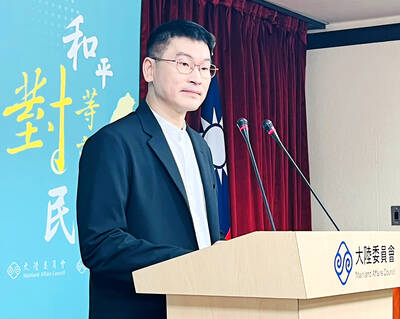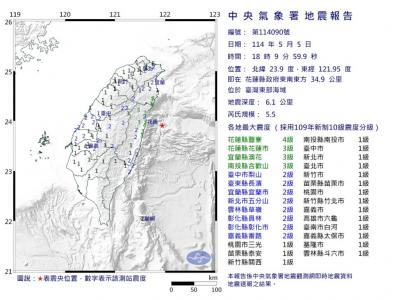Minister of Transportation and Communications Mao Chi-kuo (毛治國) yesterday said the ministry aims to increase the public transport usage rate from about 14 percent to 30 percent, with a goal of a 5 percent increase annually.
Mao made the statement at a transportation service seminar held by the ministry, where he delivered a speech titled “Vision of a Low Carbon Emission, Sustainable Transport Development.”
Meanwhile, the ministry has proposed that local governments consider raising their parking fees and charging a congestion fee to boost demand for public transport.
The Executive Yuan’s Energy Saving and Carbon Reduction Committee has ordered the transportation department to reduce carbon dioxide emissions to 34.5 million tonnes by 2020 and 29.7 million tonnes by 2025, but the best the department could do is halve the carbon dioxide emissions now being produced, Mao said.
A majority of the work needs to be done by the nation’s energy regulator, which must ensure a more efficient use of the energy, Mao said.
Oil prices rose 385 percent between 1995 and last year, but the consumer price index only rose 83 percent during the same period, he said, asking whether fuel purchases should still be subsidized, given the rising cost of crude oil.
“The question we have to ask ourselves is whether we are ready to take care of those who switch from private vehicles to public transport if the government no longer provides subsidies for gas purchases,” Mao said. “When that happens, a public transport environment must be in place, otherwise people will only switch from cars to motorcycles.”
To decrease reliance on small passenger vehicles, the ministry said it would promote increased use of carbon-free options, such as walking and bicycling.
Commuters should also be encouraged to carpool and use public transport at least once per week or per month, and to try to work from home using Web-based videoconferencing.
Mao said transportation had become the second-largest energy-consuming sector after industry, with as much as 13.9 percent of energy resources going into transportation last year, emitting about 35.3 million tonnes of carbon dioxide.
Statistics from last year showed that the carbon dioxide generated by highway transportation accounted for 94 percent of all transportation emissions.
Sixty-four percent of carbon dioxide emissions on highways came from small passenger vehicles.
Mao said a survey conducted last year found that the public transport usage rate was 13.9 percent. When those who walk or ride bicycles were added, the percentage was 26.7 percent.
New Taipei City (新北市), Keelung and Taoyuan County also have double-digit public transport usage rates, but the usage rate for other cities and counties varied between 3 percent and 8 percent.
The divide was also obvious when comparing public transport utilization in the nation’s five major municipalities.
Taipei and New Taipei City had public transport usage rates of 37.6 and 25.9 percent respectively, but those of Greater Taichung, Greater Tainan and Greater Kaohsiung were 6.8, 4.8 and 6 percent respectively.

An essay competition jointly organized by a local writing society and a publisher affiliated with the Chinese Communist Party (CCP) might have contravened the Act Governing Relations Between the People of the Taiwan Area and the Mainland Area (臺灣地區與大陸地區人民關係條例), the Mainland Affairs Council (MAC) said on Thursday. “In this case, the partner organization is clearly an agency under the CCP’s Fujian Provincial Committee,” MAC Deputy Minister and spokesperson Liang Wen-chieh (梁文傑) said at a news briefing in Taipei. “It also involves bringing Taiwanese students to China with all-expenses-paid arrangements to attend award ceremonies and camps,” Liang said. Those two “characteristics” are typically sufficient

A magnitude 5.9 earthquake that struck about 33km off the coast of Hualien City was the "main shock" in a series of quakes in the area, with aftershocks expected over the next three days, the Central Weather Administration (CWA) said yesterday. Prior to the magnitude 5.9 quake shaking most of Taiwan at 6:53pm yesterday, six other earthquakes stronger than a magnitude of 4, starting with a magnitude 5.5 quake at 6:09pm, occurred in the area. CWA Seismological Center Director Wu Chien-fu (吳健富) confirmed that the quakes were all part of the same series and that the magnitude 5.5 temblor was

The brilliant blue waters, thick foliage and bucolic atmosphere on this seemingly idyllic archipelago deep in the Pacific Ocean belie the key role it now plays in a titanic geopolitical struggle. Palau is again on the front line as China, and the US and its allies prepare their forces in an intensifying contest for control over the Asia-Pacific region. The democratic nation of just 17,000 people hosts US-controlled airstrips and soon-to-be-completed radar installations that the US military describes as “critical” to monitoring vast swathes of water and airspace. It is also a key piece of the second island chain, a string of

The Central Weather Administration has issued a heat alert for southeastern Taiwan, warning of temperatures as high as 36°C today, while alerting some coastal areas of strong winds later in the day. Kaohsiung’s Neimen District (內門) and Pingtung County’s Neipu Township (內埔) are under an orange heat alert, which warns of temperatures as high as 36°C for three consecutive days, the CWA said, citing southwest winds. The heat would also extend to Tainan’s Nansi (楠西) and Yujing (玉井) districts, as well as Pingtung’s Gaoshu (高樹), Yanpu (鹽埔) and Majia (瑪家) townships, it said, forecasting highs of up to 36°C in those areas